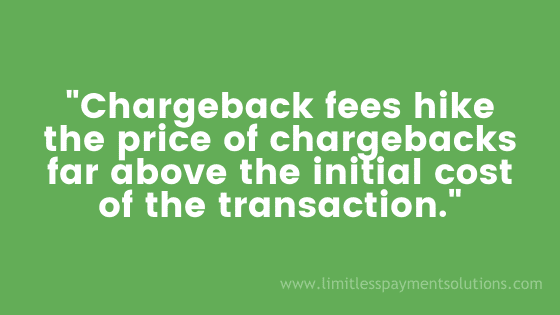
6 Business-Saving Tips to Handle Your High-Risk Industry
Consumers are consistently doing more shopping online. Globally, the e-commerce market is expected to reach nearly $5 trillion and account for roughly 18% of all retail sales by 2021.
As shoppers increasingly buy online, small business online merchants which accept credit cards face an increased risk of high chargebacks and payment fraud. According to the Merchant Risk Council, online businesses lose 1.8% of revenue to fraud, and each dollar in chargebacks costs businesses $2.94.
What is a chargeback?
Before we can discuss how to prevent and avoid chargebacks, it’s important to understand what they are and how they work.
Chargebacks occur when money is returned to a consumer’s original method of payment, usually an online transaction, using a credit card, bank account, or line of credit. When a customer disputes a transaction for goods or services, either due to fraud or another error, they contact their bank or credit card company directly. They may need to explain their complaint or provide compelling evidence to prove their case, but not always. The issuing bank or credit company then would investigate and could issue the return to the customer’s payment method.
The process looks something like this:
- The customer contacts the bank or credit card company
- The bank gathers additional information to determine the validity of the request
- Persistent customers are often granted the chargeback
- The credit is usually provisional until the bank or credit card company contacts the merchant’s bank
- The customer’s bank will then transfer the money from the merchant’s account back to the customer
- If the merchant doesn’t dispute this claim, ignores the chargeback, or accepts it, the refund is finalized

Chargebacks and disputes are two words that are often used interchangeably. While they are similar, not all disputes result in a chargeback. Unfortunately, the negative consequences of disputes will always fall on merchants because regardless of whether the disputed charge is won or lost by the consumer, the dispute itself will contribute to a high chargeback ratio for the merchant. It’s much better to take an active strategy upfront to prevent them from occurring in the first place.
Even businesses that don’t operate in high-risk industries risk becoming classified as a high-risk merchant if their chargeback rate is too high. Any business with too high of a chargeback ratio will not be able to operate regardless of their industry. If you’re dealing with a high chargeback ratio, these tips can help you get it back under control.
Why would a consumer initiate a chargeback?
Customer disputes are sometimes initiated due to fraud—but not always. While fraud is a growing online trend, some consumers take advantage of this fact, requesting chargebacks even after they’ve received and used your product or service. This is known as “friendly fraud” and is anything but friendly.
Here are some of the most common reasons customers request a chargeback:
- The credit card was used without permission by someone other than the cardholder
- The customer claims they never received the product or service
- The product or service was not as promised (damaged, falsely advertised, etc.)
- The customer doesn’t recognize the transaction and claims they never authorized it
Although chargebacks are designed to protect both consumers and merchants, all too often customers take advantage of the process—and it’s the business owners who suffer.
Why are chargebacks so costly?
No one likes to lose a sale—especially if you’ve already delivered the product or service. Not only is the business out the cost of the product but now also the purchase price. However, chargebacks aren’t the only expenses merchants face when a chargeback is issued. Your bank will also charge you a fee for performing the chargeback.
This fee varies and is intended to cover any chargeback-related costs that your bank incurs during the chargeback process. Fees vary depending on the bank branch, credit card network, and payment processors. Each party involved with the transaction has its own fees, and you’ll be required to pay accordingly.
It’s these fees that hike the price of chargebacks far above the initial cost of the transaction. In fact, most chargebacks cost the merchant over $2.00 on the dollar. That means that if you lose a chargeback claim for a $100 transaction, you’re actually losing $200! This is why preventing chargebacks is so important for protecting your business and bank account.

What can I do to prevent this?
Use clear payment descriptors
Ensure the company name on the payment description matches the name of your e-commerce storefront and is clearly recognizable to the consumer. You can reduce your risk of friendly fraud by making sure customers can immediately identify and understand transactions with your business on their credit card statement. This is especially important for companies that do business under more than one name. Consumers will usually report a charge they don’t recognize to their bank or credit card company.
Know the red flags for suspicious orders
Foreign orders, especially from countries known for rampant credit card fraud, and abnormally large orders outside what’s typical for your business are two indicators that a charge deserves additional scrutiny. Multiple failed charge attempts from the same IP address also strongly suggests someone is testing a stolen card. It never hurts to verify the order with the customer when you feel that something’s not quite right.
Upgrade your customer service processes
Include a working phone number in your payment descriptors so customers can contact you with a problem before they contact their bank. If you can resolve the problem with a phone call, you can save yourself a lot of time and money.
Remind customers with recurring charges of upcoming payments so they know to expect it.
Make it easy for them to cancel or downgrade their service or subscription. If you put roadblocks in the cancellation process, customers will use chargebacks to get out of the commitment—usually for several months of recurring fees.
Be generous in your refund policies. It is almost always far less expensive to make a complete refund than to deal with a chargeback. Simply making sure your hours are updated online and your customer service team is easily accessible will prevent any chargeback from being submitted in the first place. Transparency is key. Prevent customers from filing chargeback claims by offering impeccable customer service. Be available for customers to email, call, or live chat. This encourages customers to contact you directly with any questions or concerns regarding a recent transaction. It puts you, the merchant, in a better position of power.
Follow CNP protocols faithfully
Specific requirements for Card Not Present (CNP) transactions allow for extra security online. You may need to use AVS and CVV verification, track the customer’s IP address, and even document shipment and delivery. Not only will you catch more fraudulent transactions on the front end when you follow these protocols, but you also avoid an automatic decision against you in the event of a chargeback.
Be sure you keep meticulous records of the information you collect on each card not present transaction. In the event you do need to fight a chargeback, you need proof that the transaction was handled properly.
Consider a mediation service
If chargebacks are becoming a problem for your company, consider investing in an alert system as the most effective way to manage disputes before they become chargebacks at all.
For example, Ethoca Alerts mediates between banks and merchants and notifies merchants of issuer-confirmed fraud and customer disputes in near real time – providing the necessary communication between banks and merchants quickly enough to potentially avoid a chargeback altogether.
Other full-service dispute management suites such as VeriFi or MiDiGATOR, provide solutions that enable your business to learn about disputes in real time and act accordingly before the chargeback occurs. This is certainly the most effective way to manage your future chargeback ratio and be sure that your company stays on track without any surprises.
Evaluate your payment processing solution
New businesses and startups face a smaller risk of online fraud, but as they scale their business, the risk increases exponentially. Unfortunately, the payment solution that worked when your business processed 15 or 20 transactions a day may not have the seller protections you need when you’re processing hundreds or thousands of transactions.
It could also be advantageous to get multiple merchant accounts to have a backup and to distribute your monthly volume and chargebacks. If you evenly distribute your chargebacks between multiple accounts, your chargeback ratio will be lower for each account.
Protecting Yourself Against Chargebacks in 2020
When the U.S. chargeback policy was written, it was designed to protect consumers. It essentially offers buyers a way of forcing a refund without having to settle with the merchant. At best, this is a great option for individuals who have suffered from fraud or identity theft; at worst, chargebacks are a way for criminals to defraud merchants in vulnerable markets.
Either way, chargebacks create unique problems for merchants, particularly if they are part of an industry that banks consider to be “high-risk.” A merchant can be considered high-risk if they are more susceptible to higher chargeback rates, meaning banks would have to spend time and resources processing chargeback claims and refunding credit-card transfers.
Running an online business is never without risk. In a digital world where fraud does exist and millions of consumers are making online purchases every minute, considering a prevention strategy is necessary — especially for businesses operating in high-risk industries.
Are you running a high-risk online business? If so, you deserve professionals experienced in protecting your rights and the ability to do business safely and securely.
Limitless Payment Solutions Can Help
Chargebacks are expensive, so it’s in your best interest to stop them before they occur. If your business is experiencing a high volume of chargebacks, Limitless Payment Solutions can help you get the high risk merchant account solutions that you need to grow your business.